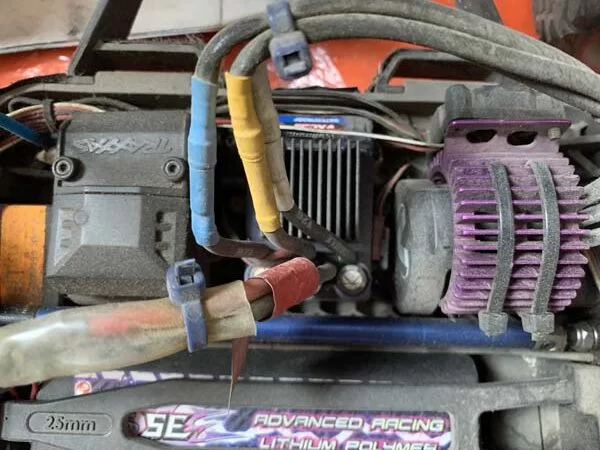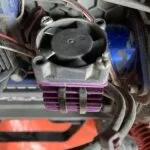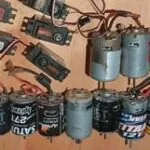Do RC heat sinks actually work (do you need one?)

A heat sink is a cooling device you can attach to your RC car to protect the motor from excessive heat.
Heat sinks are built with high-quality copper or aluminum materials with fins to give the RC motor a larger surface area and air space for proper ventilation.
Many seasoned RC enthusiasts believe attaching a heat sink to your RC motor will prevent further damage and expensive repairs on electronic components while others believe that the fan works better than the heatsinks.
Does heat sink actually work?
One of the major questions when considering buying a heatsink is whether they actually work.
Well, heatsinks do work. The main purpose of the heatsink is to create a larger surface area for heat to expand, and that allows airflow on your RC vehicle to help reduce power consumption and act as a cooling agent.
There’s a 99% chance that your RC motor will overheat due to poor ventilation. When your RC car does not receive the adequate amount of air flow needed to cool the motor and ESC, you end up damaging essential functions like the gear and bearings.
How does a heat sink work?
Heat sinks work by distributing the heat of your motor to prevent damage to other electronic components. It does this by absorbing the extra heat the motor produces.
If your RC car\plane\heli\boat has little to no space, you want to know that a heat sink comes with a fin that increases the surface area for better air circulation.
In essence, heat sinks work by redirecting the heat flow from the motor by increasing the available space or surface area of the RC motor.
However, for a heatsink to work, it must have much higher temperature levels than your RC car to absorb heat easily.
Heat sink’s heat transfer coefficient
Heat transfer coefficients calculate convection losses and thermal conductivity resistance rate in your RC car. This coefficient helps you achieve an accurate and fast conduction-based thermal analysis of your heat sink.
Technically the formula to test for heat transfer is
Q = h ∗ S ∗ (Tp – Tₐ)
Where:
- Q = heat transferred, J/S = W
- h = heat transfer coefficient, W/(m² K)
- S = transfer surface, m²
- Tp = Plate Temperature, K
- Tₐ = Air temperature, K
However, the general definition heatsink heat transfer coefficient is:
- h = q∆T
Where:
- q = the thermal power per unit area, W/m²
- h = heat transfer coefficient, W/(m² •K)
- ΔT = the difference in temperature between the solid surface and surrounding fluid area, K.
Are heat sinks better than fans?
Heatsinks and fans both work to dissipate heat. Surprisingly, they are both lightweight even when they come in varying sizes. However, what sets them apart is in their sound, their efficiency performance-wise, and the ease at which you can maintain them.
Heatsinks are usually easy to use and can fit any RC car without you worrying about the weight distribution. They often last longer than fans since they are made with top-tier copper and aluminum sheets. Plus, they won’t make annoying sounds when you use them. The opposite is the case for the fans as they often make noisy sounds, aren’t as easy to install as heatsinks, and require regular maintenance due to their build quality.
Ultimately, heatsinks are better than fans since their pro outweighs that of fans.
Do you have to have a heat sink in your RC vehicle?
Your RC is prone to overheating because components like the ESC, battery and motor produce heat when running for long hours and its maximum RPM.
If you’re constructing an RC car or are considering buying one, heatsinks are a must-have since they help you maintain proper temperature levels in the RC car by absorbing the extra heat the motor, battery, and ESC generates and also extend their life.
Without a heatsink, the heat these heat-producing agents generate will damage essential car functions making your car idle and causing several damages that may lead to expensive repairs. With a heatsink, it’s easy to protect other components of your RC car while ensuring they last the whole length of their shelf life.
*That being said, its also important to consider the temp in which you will run your RC. In a cold environment, the need for a heatsink reduces drastically.
What are heat sinks made of?
The two most common materials used in making heatsinks are aluminum alloys and copper.
These materials have a high heat capacity and thermal conductivity that helps absorb heat efficiently without generating higher temperature levels while cooling the RC motor.
Which is a better heatsink for RC motor -copper or aluminum?
Aluminum is mechanically soft but has one of the highest thermal conductivity values at 229 W/(m·K) and a heat capacity of 922 J/(kg·K).
On the other hand, copper has effective heat absorbing properties in terms of thermal conductivity and even around twice the thermal conductivity of aluminum, at 400 W/(m·K).
Copper heatsinks are three times more solid than their aluminum counterparts. However, they are more expensive than aluminum and less flexible.
Ultimately, if you’re considering getting a heatsink for your RC car and can afford an expensive one, the copper heatsinks will work more effectively.
However, if you need one that is more flexible and can suit a less-priced budget, high-quality aluminum will be the best option.
Are heat sinks for electric, nitro, or both?
Heat sinks work exceptionally for both electric and nitro RC vehicles.
The nitro engine uses a head heatsink that dissipates the heat from the engine block, while on an electric car, the clip-on motor heat sink helps draw out heat to keep the motor cool.
Conclusion
If you have an RC car, use it frequently and at its maximum RPM; getting a heat sink is important because they work effectively to dissipate heat. Excessive heat is one of the major causes of a faulty motor or engine. A heatsink is a device that helps you reduce the heat the engine and motor produce to keep your electric motor and nitro engine cool.
Sources used for this article
https://www.engineersedge.com/thermodynamics/convective_heat_transfer.htm
https://en.wikipedia.org/wiki/Heat_sink#Material
https://altasimtechnologies.com/estimating-heat-transfer-coefficients/





